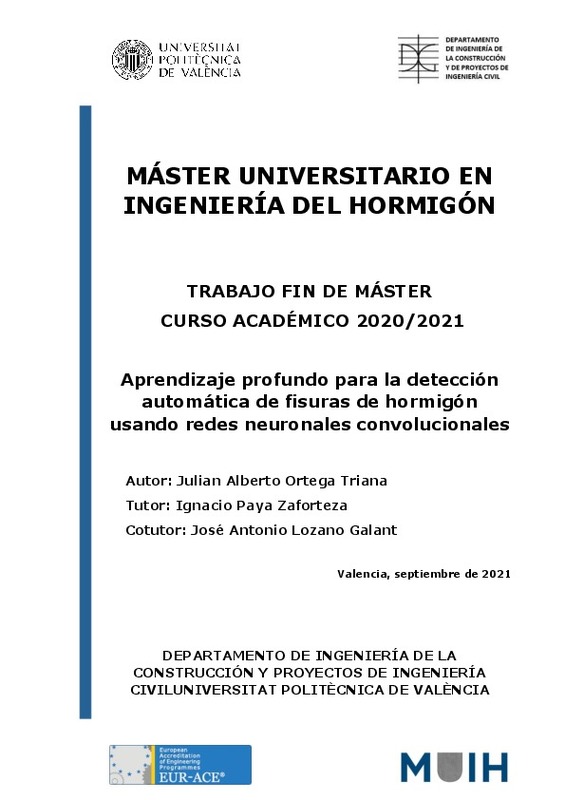JavaScript is disabled for your browser. Some features of this site may not work without it.
Buscar en RiuNet
Listar
Mi cuenta
Estadísticas
Ayuda RiuNet
Admin. UPV
Aprendizaje profundo para la detección automática de fisuras de hormigón usando redes neuronales convolucionales
Mostrar el registro sencillo del ítem
Ficheros en el ítem
| dc.contributor.advisor | Payá Zaforteza, Ignacio Javier
|
es_ES |
| dc.contributor.advisor | Lozano Galant, José Antonio
|
es_ES |
| dc.contributor.author | Ortega Triana, Julian Alberto
|
es_ES |
| dc.date.accessioned | 2021-10-19T09:55:01Z | |
| dc.date.available | 2021-10-19T09:55:01Z | |
| dc.date.created | 2021-09-23 | |
| dc.date.issued | 2021-10-19 | es_ES |
| dc.identifier.uri | http://hdl.handle.net/10251/174954 | |
| dc.description.abstract | [ES] El envejecimiento de las infraestructuras hace de suma importancia el desarrollo de herramientas eficaces y rápidas en el área de patología estructural que permitan detectar potenciales patologías estructurales. Esto permite actuar rápidamente y evitar la degradación de la estructura y posteriores fallos. En este contexto, este TFM tiene como objetivo desarrollar una herramienta de deep learning basada en redes neuronales convolucionales para la detección automática de fisuras en superficies de hormigón. De esta manera y para cumplir con el objetivo propuesto, se utilizó el aprendizaje por transferencia, una de las técnicas más importantes del deep learning para el aprendizaje automático en inteligencia artificial, que consiste en la modificación de algunos patrones ya entrenados de las redes neuronales, que reconocen una serie de características generales para reconocer otras más específicas. En consecuencia, en este trabajo se comparó la efectividad, precisión y tiempo de procesamiento de tres arquitecturas de redes neuronales convolucionales (GoogleNet, AlexNet y SqueezeNet) que se entrenaron con dos bases de datos (SDNET2018 y METU) para detectar específicamente fisuras de hormigón mediante la técnica del fine tunning, con el fin de escoger solo una red que lograra identificar las fisuras de forma eficaz. Así, los resultados muestran que con Googlenet se clasifican las imágenes fisuradas y no fisuradas con una tasa de éxito del 93% . Además, se logra detectar una grieta dentro de una región de interés delimitada y se consigue determinar el momento de aparición de una fisura analizando un video de rotura de una viga. Por consiguiente y mediante este proceso, se generó una herramienta que es el punto de partida para la detección de fisuras y que, con un mayor desarrollo en el futuro, permitirá clasificar automáticamente patologías en estructuras de mediante una red neural entrenada. | es_ES |
| dc.description.abstract | [EN] The aging of infrastructures makes the development of fast and effective measures, that will allow for the detection of potential structural pathologies, in the field of structural pathology, essential. This makes it possible to act fast, thus avoiding the degradation of the structure and any following malfunction. In this context, this master's thesis aims at developing a deep learning tool based on convolutional neuronal networks for the automatic detection of fissures on concrete surfaces. Thus, and with the aim of achieving the proposed objective, transfer learning was used, one of the most important deep learning techniques for artificial intelligence applied to automatic learning. It consists of the modification of some ¿ already learnt- patterns of neuronal networks, recognizing certain general characteristics in order to then recognize some more specific ones. Consequently, this work compared the efficacy, precision, and processing time of three convolutional neuronal networks architectures (GoogleNet, AlexNet y SqueezeNet), which were gathered from two databases (SDNET2018 y METU) to specifically find fissures in concrete through the fine-tuning technique, with the aim of choosing one network that could effectively complete the new classification task. Thus, the results show that GoogleNet classifies fissured and non-fissured images with a 90% success rate. Moreover, it can detect a crack on a limited region of interest and determine the moment in which a fissure will appear by analyzing a video of the rupture of a rafter. Consequently, through this process, a toll was generated, that will be the starting point for the detection of fissures, and that, with further development, in the future will be able to automatically classify structural pathologies through a trained neuronal network. | es_ES |
| dc.format.extent | 113 | es_ES |
| dc.language | Español | es_ES |
| dc.publisher | Universitat Politècnica de València | es_ES |
| dc.rights | Reserva de todos los derechos | es_ES |
| dc.subject | Aprendizaje profundo | es_ES |
| dc.subject | Ingeniería estructural | es_ES |
| dc.subject | Ingeniería civil | es_ES |
| dc.subject | Inteligencia artificial | es_ES |
| dc.subject | Detección de fisuras | es_ES |
| dc.subject | Transferencia aprendizaje | es_ES |
| dc.subject | Redes neuronales | es_ES |
| dc.subject | Crack Detection | es_ES |
| dc.subject | Transfer learning | es_ES |
| dc.subject | Neural networks | es_ES |
| dc.subject | Deep learning | es_ES |
| dc.subject | Structural engineering | es_ES |
| dc.subject | Artificial intelligence | es_ES |
| dc.subject | Civil engineering | es_ES |
| dc.subject.classification | INGENIERIA DE LA CONSTRUCCION | es_ES |
| dc.subject.other | Máster Universitario en Ingeniería del Hormigón-Màster Universitari en Enginyeria del Formigó | es_ES |
| dc.title | Aprendizaje profundo para la detección automática de fisuras de hormigón usando redes neuronales convolucionales | es_ES |
| dc.type | Tesis de máster | es_ES |
| dc.rights.accessRights | Abierto | es_ES |
| dc.contributor.affiliation | Universitat Politècnica de València. Departamento de Ingeniería de la Construcción y de Proyectos de Ingeniería Civil - Departament d'Enginyeria de la Construcció i de Projectes d'Enginyeria Civil | es_ES |
| dc.description.bibliographicCitation | Ortega Triana, JA. (2021). Aprendizaje profundo para la detección automática de fisuras de hormigón usando redes neuronales convolucionales. Universitat Politècnica de València. http://hdl.handle.net/10251/174954 | es_ES |
| dc.description.accrualMethod | TFGM | es_ES |
| dc.relation.pasarela | TFGM\145684 | es_ES |






